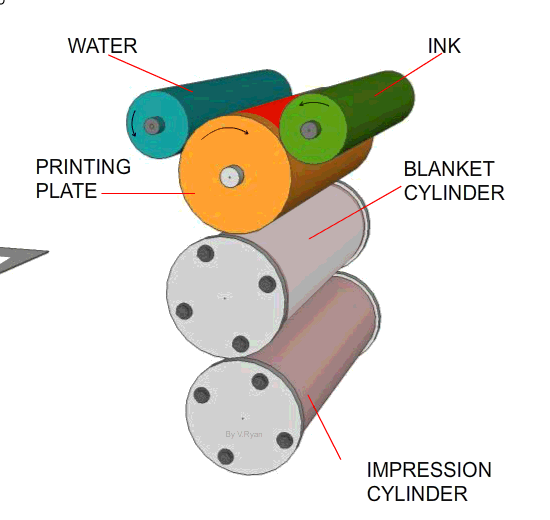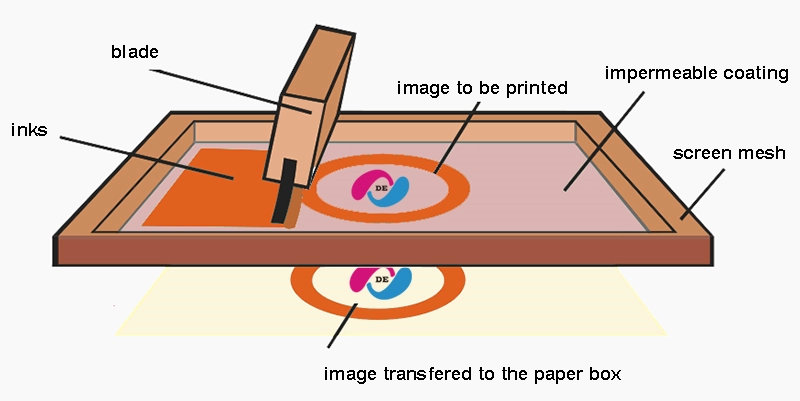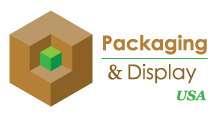Printing & Finishes
Printing
OFFSET LITHOGRAPHY
This technique is a combination of 2 older printing methods – lithography and offset, and is an indirect printing system. It’s the most prominent technique in packaging today due to its versatility in printing and high image quality.
How it works:
A plate is engraved with the image to be printed, inked and pressed into a rubber roller to be then transferred to the printing surface which must be flat. There is either a silicone layer or a dampening system in place to repel the ink where it should not be printed.
Advantages
- Able to print on a variety of surfaces – folding carton (most common), cardboard, plastic, corrugated material, metal and more
- High print quality (high resolution)
- Availability of specialty coatings such as high gloss or matte soft touch
- Color gradients in graphics appear completely smooth
- High volume intake and productivity – some machines can handle up to 15,000 impressions per hour
Disadvantages
- Print surface must be flat and no more than 24 pts thick
- Not feasible for short run or low volume projects
Best for: folding carton, rigid carton, pouches, plastic


FLEXOGRAPHY
This technique is like a modern version of the letterpress. It gets its name from the use of a flexible relief plate in the process and is often used in the printing of food packaging.
How it works:
Flexography is a direct process where the rubber printing plate transfers ink directly to the printing surface. The image is first engraved onto the plate with a laser. Then the ink is transferred from its chamber to an anilox roller where a blade removes the excess ink. After this is completed, the ink is pressed onto the printing surface, and the product is coated in the desired finishing.
Advantages
- Variety of print surfaces – corrugated paper (most common), folding cartons, paper sacks, plastic bags, food wrappers
- Lower cost per unit compared to Offset
Disadvantages
- Print quality is less than Offset (low resolution)
- Color gradients are not as smooth (colors don’t mix)
- Cannot produce photo quality images
Best for: corrugated, paper, plastic
DIGITAL/INKJET
Digital printing has grown rapidly within the industry in recent years. Its popularity is due to its precision and efficiency.
How it works:
This technique is very straightforward – the image is transferred from a device (e.g. a laptop) directly onto a variety of printing surfaces. In manufacturing, a large-format or high-volume inkjet or laser printer is used.
Advantages
- High resolution & great quality of photographic and fine art print
- Low cost per unit for short-runs
- More efficient than silkscreening
Disadvantages
- Does not offer as many coating options (see Offset printing)
- Cannot use metallic ink
- Colors may be difficult to match
- Large volumes are more costly
Best for: folding cartons, corrugated, pouches


SILKSCREEN
How it works:
This process uses mesh to transfer ink onto a print surface with the use of a blocking stencil to guide ink placement. Machines move a blade across the screen to fill the open mesh sections with ink. Finally, the blades reverse which causes the screen to momentarily touch the surface. When screen printing, you can only add one color at a time. This means that multiple screens would have to be used in sequence to produce a multicolor design.
Advantages
- Can print on any surface – PP non-woven, cloth, fabric, wood, ceramics, glass, metal
- Surface does not have to be flat
- Results are long-lasting (the composition of the ink contributes to the high quality allowing the design to last longer)
- Feasible for short-run and long-run projects
Disadvantages
- Each color has a separate application – can be time consuming depending on the design
- Need to create new screens and mesh designs for each project
- Can be expensive
Best for: plastic, fabric, wood, metal, glass
ROTOGRAVURE
This is a direct and rotary technique of printing, ideal for very high volumes.
How it works:
This process includes a rolling cylinder which is engraved with the image that has to be printed. Once completed, it is inked and pressed directly onto the print surface to transfer the image.
Advantages
- Low cost per unit when running high volumes
- Premium quality print
Disadvantages
- Does not offer many coating options
- Only feasible for high volumes
Best for: folding cartons, pouches


LASER ENGRAVING
Apart from printing, it’s also possible to label your packaging with laser engraving. Laser engraving is frequently used to engrave the product’s item, series, or batch number onto the packaging. Logos, symbols, and other line graphics can also be added via this process.
How it works:
To make packaging suitable for laser engraving, a special additive is first added to the material during production. Depending on the material and additive, different color effects can be achieved during laser engraving. The pattern results from the laser beam either oxidizing or removing the material, leaving a mark wherever the beam touches the surface.
Advantages
- Cleaner and more environmentally friendly (no paints or solvents)
- Faster production (faster setup, faster marking, no cleanup)
- Ability to mark in three dimensions (e.g., round objects)
- Very precise marking (useful on very small objects and in tight spaces)
- More permanent (markings won’t rub off after repeated use)
Best for: wood, glass, metal
Finishes
LAMINATION
Lamination is the process of applying a clear plasticized protective film (polypropylene, cellulose acetate or polyester) to an entire printed surface. It improves the printed surface’s sturdiness, water resistance and tactile feel, reinforcing its quality. Lamination is applicable on all papers from 170g, and it can be matte, gloss or satin.
MATTE LAMINATION
Matte lamination is a great no-shine finish that gives a subtle, smooth texture to your print. It provides a refined, elegant effect, while accentuating the brilliance and contrast of the colors involved.
GLOSS LAMINATION
The opposite of matte, gloss lamination is a high-shine laminate with a sparkling effect. Reflecting light, it enhances colors by accentuating the depth of blacks, and gives a bright, glowing appearance.
SATIN LAMINATION
Called “soft touch” or “peach skin”, satin lamination gives excellent protection while providing a pleasant feeling in the hand, silky and soft. An original mark of quality that only this first-rate finish can offer.
VARNISHING
Varnish is a transparent, hard, protective finish or film primarily used in wood finishing but also for other materials. Varnish is traditionally a combination of a drying oil, a resin, and a thinner or solvent. It helps protect printed surfaces and prevent staining.
MATTE VARNISHING
This type of varnishing gives a smooth and non-glossy look to the printed surface. It softens the appearance of printed photographs or images, and makes small text easy to read and soft on the eyes.
GLOSS VARNISHING
This type of varnishing improves the appearance of printed surfaces by giving them a glossy look. The coated layer reflects the light and thus, it makes the color more prominent, bright, and vivid.
SILK VARNISHING
This type of varnishing is a great middle ground between a matte and gloss finish. Silk varnishing is ideal if you want the benefits of gloss alongside the benefits of the matte finish.
UV VARNISHING
In this type of varnishing, the ultraviolet technique is applied to produce a transparent finish to your printed materials. With the help of UV lighting, the coating is dried. This type of varnish makes colors more attractive and vivid and also, provides a smooth and glossy layer to the printed surface.
ALL OVER UV VARNISH
In this type of varnishing, a UV seal is applied all over the printed surface. A gloss UV varnish is the most common type of all-over UV varnishing. Sometimes, silk and matte varnish are also available with all over UV varnish.
SPOT UV VARNISH
In this type of varnishing, a UV varnish is applied only on selected areas or spots of the printed surface. Spot UV varnish effectively gives texture and focal interest to different areas of the printing surface while leaving other areas untreated.
EMBOSSING
Embossing raises parts of the print for emphasis and texture. It adds a tactile dimension to your design. Images and text are literally felt. Embossing adds physical depth to the embossed elements and thus, shadows and highlights are also produced in the design. Embossing is generally applied in conjunction with other techniques like foil stamping or spot UV lamination to enhance the effects of both techniques.
FOIL STAMPING
Foil stamping is the use of a malleable metallic material (foil) applied to the print surface by using heat and pressure. A variety of foils can be used, including gold, silver, pigmented, holographic and security foils. Foil stamping adds reflective properties to various elements of your design, and it’s mainly used to highlight text and logos. It is usually done in combination with embossing.
DIE CUTTING
Die cutting is a fabrication process that uses specialized machines and tools to convert stock material by cutting, forming, and shearing. A specialized piece of metal tooling called a die cutter is used to cut a specific section out of a material and create custom shapes. The manufacturer uses dies, which are carbonized steel shapes with sharp, raised designs. A die design consists of solid metal, with sections cut out into a pattern or picture. Once cut, your material will replicate the die – the solid sections will remain, while the apertures will be cut away.
DEBOSSING
This is one of the more traditional printing techniques available in the market and is the opposite of embossing. A letterpress is used to depress or indent certain portions of the page. Debossing is mainly used for pressing logos.
THERMOGRAPHY
Thermography produces a raised finish to selected areas (logo, texts, etc.). This is a less expensive technique to highlights particular areas of the printed surface. Different thermographic powder gives different finishes:
- Metallic powder gives a metallic sheen to the surface
- Glitter powder gives a sparkling and dazzling effect to the surface
- Fluorescent powder makes the colored finish brighter and vivid
